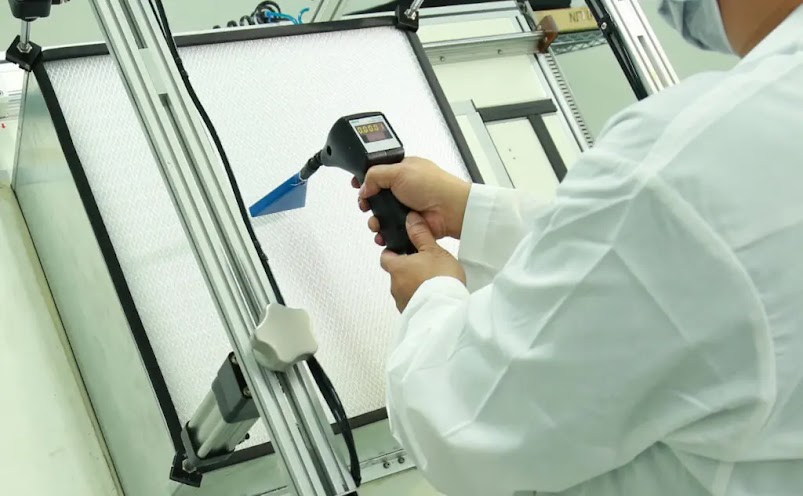DOP (Dispersed Oil Particulate) testing is a critical method for evaluating the efficiency of cleanroom filters and air systems. This test ensures that cleanrooms maintain the necessary air quality and particulate control, which is essential for industries like pharmaceuticals, biotechnology, electronics manufacturing, and aerospace. Adhering to strict standards for DOP testing is essential to maintain compliance with regulatory guidelines and ensure a contamination-free environment.
1. Understanding DOP Testing
DOP testing involves introducing a fine mist of oil particles into the cleanroom's airflow to simulate potential contaminants. The particulate concentration is then measured both before and after passing through HEPA (High-Efficiency Particulate Air) or ULPA (Ultra-Low Penetration Air) filters. By assessing how well the filters capture particles, the test helps to verify the efficiency of the filtration system and its ability to maintain the cleanroom’s air cleanliness standards.
2. Key Standards and Guidelines for DOP Testing
Several standards and guidelines are recognized worldwide to regulate and ensure proper DOP testing practices in cleanrooms. These include:
ISO 14644-3:2019: This standard provides guidelines for testing cleanroom performance, including particle counting and airflow velocity. It specifies methods for DOP testing and validation of air filtration systems in cleanrooms.
United States Pharmacopeia (USP) <797>: For pharmaceutical manufacturing cleanrooms, USP <797> provides guidelines for particulate control, requiring DOP testing to assess filter performance and ensure the air meets the required cleanliness levels for sterile compounding.
Federal Standard 209E (retired): Although this federal standard was officially replaced by ISO 14644-1, it had previously been one of the most widely used standards in the U.S. for cleanroom certification. It included guidelines for particle count testing and DOP testing as part of cleanroom validation.
European Union GMP Guidelines: The Good Manufacturing Practice (GMP) guidelines in the EU also require DOP testing for cleanrooms used in the production of pharmaceuticals, particularly for air filtration systems and the qualification of air cleanliness.
3. Testing Procedure
The process of DOP testing typically follows these steps:
Preparation: Ensure that the cleanroom is operating under normal conditions before testing. The air handling systems should be running, and the cleanroom should be at the required operational status (e.g., temperature, humidity, and airflow rate).
Injection of DOP: A DOP generator is used to disperse oil mist particles (approximately 0.3 microns) into the air system. This is usually done by injecting the DOP aerosol into the air intake or directly into the airflow.
Measurement: After the mist passes through the filters, particle counters or photometers are used to measure the concentration of particles before and after the filtration system. The difference between the two readings indicates the efficiency of the filter.
Evaluation: The results are compared to the cleanroom’s particle count limits (based on ISO classifications) to determine if the filtration system is working within the required specifications.
4. Why is DOP Testing Important?
Compliance: Regulatory authorities in sectors like pharmaceuticals, healthcare, and aerospace require cleanrooms to maintain certain air cleanliness levels. DOP testing ensures compliance with international standards like ISO 14644, USP, and GMP guidelines.
Filter Integrity: DOP testing verifies that HEPA and ULPA filters are intact and functioning correctly. It helps detect leaks or damage in filters, which could compromise the cleanliness of the environment.
Operational Efficiency: Routine DOP testing allows for proactive maintenance and optimization of cleanroom filtration systems. This can prevent downtime, costly repairs, or compromised product quality.
Quality Assurance: In high-stakes industries such as pharmaceuticals or electronics, product quality is directly impacted by environmental conditions. DOP testing helps ensure that the cleanroom provides the optimal environment to protect products from contamination.
5. Best Practices for DOP Testing
To ensure accurate and reliable DOP testing, the following best practices should be followed:
Routine Testing: DOP testing should be performed regularly to ensure that the air filtration systems continue to perform effectively. This is especially important for critical cleanrooms that operate 24/7.
Proper Calibration of Instruments: Ensure that particle counters and photometers are calibrated correctly to provide accurate results.
Test Under Normal Operating Conditions: DOP testing should be done when the cleanroom systems are running at full capacity to simulate actual operating conditions.
Professional Oversight: DOP testing should be carried out by certified professionals with expertise in cleanroom certification and testing to ensure proper procedures are followed.
6. Conclusion
DOP testing for cleanrooms is a vital part of maintaining air quality and ensuring the integrity of sterile environments. By adhering to established standards such as ISO 14644 and USP <797>, cleanroom operators can verify the efficiency of their filtration systems and confirm that their environment remains free from contaminants. Consistent and proper testing not only ensures compliance with industry regulations but also safeguards the quality and safety of the products manufactured in these controlled spaces.

Comments
Post a Comment